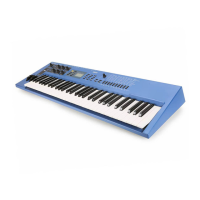35
UTILTIY. In other words, you can generate Controller data
with the Knobs or Mod wheel for any MIDI channel, and
record this data with your sequencer. This even works in
Multi mode!
AMPLE:
You are creating a song and wish to generate simultaneous
filter and resonance modulation on MIDI channel 12 (set
MIDI Ch. 12 in the sequencer‘s recording parameters).
Now start recording (Record) and play with Knobs CUTOFF
and RESONANCE. All movements will be recorded as Con-
troller messages 74 and 71.
It gets better still: you can also use this method to send
Controller messages to other Synthesizers or tone modules.
AMPLE:
Let‘s say you want to control another YAMAHA synthe-
sizer‘s VARITAION Effect Send Level on MIDI channel 16.
These CS1x UTILITY settings are required:
TRANS CH = 16, ASSIGN CTRL NO = MW (move the
Mod wheel), 94: Vari.
Now start to record, and use the Mod wheel to set the Vari-
ation Effect Send Level. Any wheel movements will be
recorded as Controller 94 messages.
Everything under control:
NPRN and RPN
The NRPN (“Non-registered Parameter Number”) and RPN
(“Registered Parameter Number”) are special kinds of Con-
troller message.
A single event here isn‘t enough. Parameter selection fol-
lows a similar path to that of Bank Change messages, i.e.
Controller messages are sent for both the MSB and LSB val-
ues. This is then followed by a third Controller message
which represents the parameter value (“Data Entry”). The
RPN concludes its data transmission with a further two Con-
troller events (“Reset to 0”).
This multitude of events can make a sequencer track a little
difficult to follow. It is possible to use a single Sys-Ex mes-
sage to control any of the parameters NRPN and RPN can
control, hence you should look at each case individually to
decide whether NRPN/RPN or Sys-Ex messages are appro-
priate. For example, NRPN/RPN messages may be prefera-
ble in these two cases:
• You decide you only occasionally need to control
parameters in addition to the ones listed above via MIDI
(e.g. Decay Time, Fine Tune…) and don‘t wish to get
involved with Sys Ex data.
• One of your parameters isn‘t just initialised at the
beginning of the song but continuously varied within
the song. Once the parameter is called up these
changes only require a single Controller event, i.e. the
data stream will be significantly smaller than with Sys-
Ex messages!
You will find a complete list of NRPN and RPN in the
Appendix of your manual. You may notice that some of the
parameters with their own Controller number (see previous
section) crop up in this list also (e.g. Cutoff Freq, Attack
Time). We can forget about these however; it would be silly
to input them via NRPN, where they would require several
Controller events, when a single Controller can be used
instead.
Below is a list of parameters which can only be controlled
via NRPN. Each value is also listed using decimal notation as
most sequencer programs don‘t allow hexadecimal values
for input:
Table: NRPN Parameters
All drum parameters in this list can be programmed sepa-
rately for each instrument (i.e. each key). It is therefore
required to specify the relevant note number which can be
found in the first row of the XG Drum Map. You will not need
to convert these numbers as the XG Drum Map values are
given in decimal.
Any changes you make to the drum parameters affect the
drum set used in the respective PART MODE track. For more
detail consult section “Part Mode and Drum Setups”.
In addition to the above Controller messages #99 and #98,
a NRPN transmission requires a further message, Control #6
(DATA ENTRY) to enter the parameter value. To make this a
little clearer here are three short examples to demonstrate
how parameter changes are achieved via NRPN.
AMPLE:
AEG Decay Time
Control 099 001
Control 098 100
Control 006 64
The first two Controls call up the Decay Time parameter,
Control 006 then sets the required parameter value. We have
chosen value 64 for this example – this is equivalent to initial
value +00 in the CS1x.
Parameter Cntr 99
(MSB)
hexa-deci-
mal
Cntr 98
(LSB)
hexade-
cimal
Cntr 99 (MSB)
decimal
Cntr 98
(LSB)
decimal
Vibrato Rate 01H 08H 1 8
Vibrato Depth 01H 09H 1 9
Vibrato Delay 01H 0AH 1 10
EG Decay Time 01H 64H 1 100
Drum Cutoff Freq. 14H note number 20 note number
Drum Resonance 15H note number 21 note number
Drum Attack Rate 16H note number 22 note number
Drum Decay Rate 17H note number 23 note number
Drum Pitch Coarse 18H note number 24 note number
Drum Pitch Fine 19H note number 25 note number
Drum Level 1AH note number 26 note number
Drum Pan 1CH note number 28 note number
Drum Reverb Send 1DH note number 29 note number
Drum Chorus Send 1EH note number 30 note number
Drum Variation Send 1FH note number 31 note number

